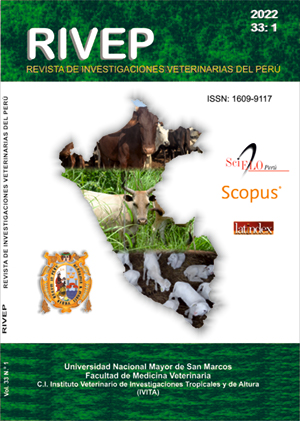Importance of mycoses in aquaculture. Is phytotherapy a surpassing alternative for its treatment with respect to conventional treatments?
DOI:
https://doi.org/10.15381/rivep.v33i1.20338Keywords:
mycoses, alternative therapy, eggs, aquaculture, environmentAbstract
In aquaculture, the intensification of cultures of aquatic organisms to obtain large volumes of production leads to the establishment of an environment that generates stress. These conditions weaken the immune system of these organisms, which increases the spread of diseases and generates great economic losses. One of the factors responsible for the mortality of cultivated species is fungal infections. In farms, the handling procedures that are carried out during the incubation, rearing and fattening stages are important for the final yield. One of the crucial stages is incubation as there is usually a high degree of mortality at this stage. Several studies have been conducted using chemical products for the prophylaxis, disinfection and control of mycoses. This use has caused the resistance of pathogens and the accumulation of residues in the tissues of aquatic organisms or in the environment. For this reason, other forms of therapy that are more profitable and with less deleterious effects on the environment are being developed. Phytotherapy emerges as an alternative due to its proven action against diseases of diverse etiology. This review compiles and discusses the existing bibliography on the most common fungal diseases in fish, amphibians and crustaceans, emphasizing those that affect the eggs of cultures organisms and analyzing the natural antifungal agents used in vitro and in vivo in aquaculture.
Downloads
Downloads
Published
Issue
Section
License
Copyright (c) 2022 Silvia E. Plaul, María Laura Pérez, Jesica A. Sansiñena, Suani G. Pacheco Marino, Claudio G. Barbeito

This work is licensed under a Creative Commons Attribution 4.0 International License.
AUTHORS RETAIN THEIR RIGHTS:
a. Authors retain their trade mark rights and patent, and also on any process or procedure described in the article.
b. Authors retain their right to share, copy, distribute, perform and publicly communicate their article (eg, to place their article in an institutional repository or publish it in a book), with an acknowledgment of its initial publication in the Revista de Investigaciones Veterinarias del Perú (RIVEP).
c. Authors retain theirs right to make a subsequent publication of their work, to use the article or any part thereof (eg a compilation of his papers, lecture notes, thesis, or a book), always indicating the source of publication (the originator of the work, journal, volume, number and date).










